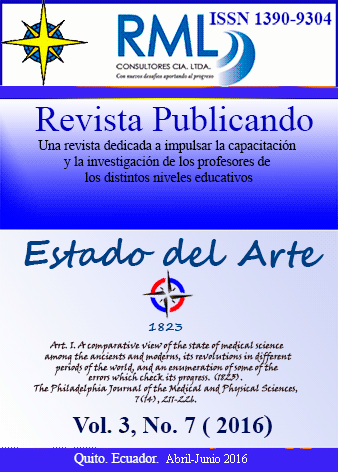Abstract
RESUMEN:
“La organización mundial de la salud (OMS, 1946) define salud como "un estado de completo bienestar físico, mental y social y no sólo la ausencia de afecciones o enfermedades.”
En el Ecuador, existe un alto índice de alteraciones en la salud bucodental en niños/as, por deficiencias en la higiene oral, siendo comunes: candidiasis (muguet) y la caries dental.
Al Centro de salud de Jaramijo acuden menores con un alto índice de manifestaciones bucodentales, por lo que es necesario fomentar en las madres los hábitos de higiene bucal en sus hijos menores, cuanto más temprano empiecen con una correcta higiene oral, menor son las probabilidades de que sus hijos desarrollen patologías bucales. Por lo que se registra la problemática: “La escaza educación preventiva en la madres, exclusivamente de higiene oral, influye significativamente en la salud oral de sus hijos”, por lo que se plantea el Objetivo Determinar el nivel de conocimiento de higiene oral en las madres y su influencia en la salud bucodental en sus hijos de 0 a 3 años, atendidos Centro de Salud Jaramijo, marzo- agosto 2014.El estudio metodológico es Descriptivo de corte cualitativo. La población fue de 80 madres de los menores de 0 a 3 años. Se evidenció que existen un alto porcentaje de madres que obtuvieron un nivel bajo en conocimiento sobre higiene oral. Por lo que se concluyó, la falta de conocimiento sobre higiene oral en las madres son los factores que inducen la presencia prematuramente de caries en los menores, por lo que se debe implementar programas de educación a las madres de este sector.
References
American Academy of Pediatric Dentistry. Policyon the dental home. Pediatr Dent. 2008-2009; Reference Manual 30:22-23. 19. American Academy of Pediatrics.
Blanco-Cedres L, Guerra ME, Rodríguez S. Lactancia materna en la prevención de hábitos orales viciosos de succión y deglución. Acta Odontológica Venezolana. 2007; 45: 71-73.30. López Y, Arias M, Zelenenko O.
Borboni Neomi, a. e. (2010). Odontología pediátrica- la salud oral del niño y el adolecente en el mundo actual. Medica panamericana.
Gibson S, Williams S. Dental caries in pre-school children: associations with social class, toothbrushing habit and consumption of sugars and sugar-containing foods. Further analysisof data from the National Diet and Nutrition Survey of children aged 1.5-4.5 years. Caries Res. 1999; 33: 101-113.
Grindefjord M, Dahllof G, Wikner S, Hojer B, Modeer T. Prevalence of mutans streptococci in one-year-old children. Oral Microbiol Immunol. 1991; 6: 280-283.
Cahuana Cárdenas A, Capell
American Academy of Pediatric Dentistry. Policyon Early Child-
hood Caries (ECC): classifications, consequences, and preventive strategies. Pediatr Dent. 2008-2009; Reference Manual 30: 40-43. 35. Díaz-Gómez NM.
American Academy of Pediatric Dentistry. Policyon the use of fluoride. Pediatr Dent. 2008-2009; Reference Manual 30: 31 -34
Caufield PW. Dental caries: a transmissible and infectious disease revisited: a position paper. Pediatr Dent. 1997; 19: 491-498. 42.
Moimaz SA, Zina LG, Saliba NA, Saliba O. Association between breast-feeding practices and sucking habits: a cross-sectional stu-dy of children in their first year of life. J Indian Soc Pedod Prev Dent. 2008; 26: 102-106.
J.C. PALMA, A. C. (2010). Guía de orientación para la salud bucal . NUTRICION INFANTIL- ACTA PEDIíTRICA, 351-357.
Carrasco, D. (s.f.). http://www.maternum.com/. Obtenido de http://www.maternum.com/Biblioteca/OdontologiaPerinatal.pdf
Dra.RUBIO.M.T. (s.f.). http://www.webconsultas.com/. Obtenido de http://www.webconsultas.com/bebes-y-ninos/afecciones-tipicas-infantiles/causas-del-muguet-oral-11511
OMS. (Febrero de 2007). ORGANIZACION MUNDIAL DE LA SALUD. Obtenido de http://www.who.int/en/: http://www.who.int/mediacentre/factsheets/fs318/es/
PREVINFAD,MIí‘ANAM, V. (2011). Promoción de la salud bucodental. REV PEDIATR ATEM PRIMARIA VOL. 13 NO.51, 435- 458.
“NIVEL
You are free to:
Share — copy and redistribute the material in any medium or format.
Adapt — remix, transform, and build upon the material.
The licensor cannot revoke these freedoms as long as you follow the license terms.
Under the following terms:
Attribution — You must give appropriate credit, provide a link to the license, and indicate if changes were made. You may do so in any reasonable manner, but not in any way that suggests the licensor endorses you or your use.
NonCommercial — You may not use the material for commercial purposes.
ShareAlike — If you remix, transform, or build upon the material, you must distribute your contributions under the same license as the original.
No additional restrictions — You may not apply legal terms or technological measures that legally restrict others from doing anything the license permits.
